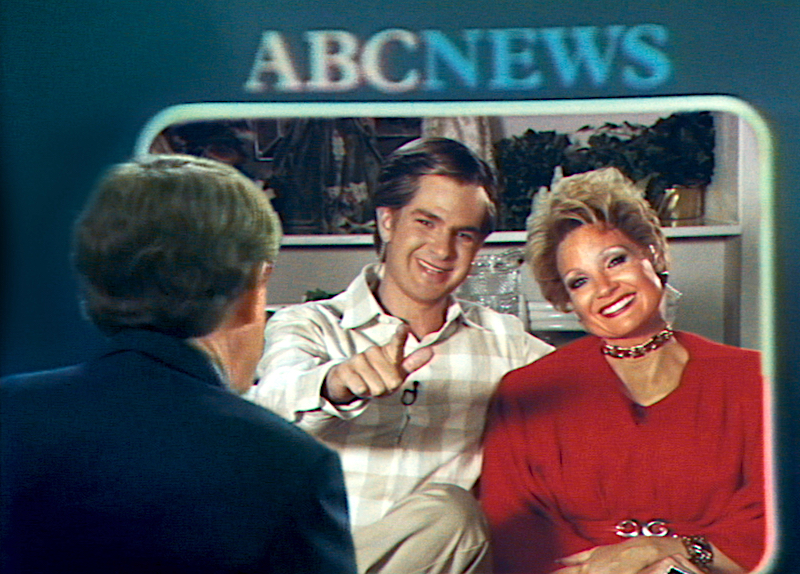Tammy Faye LaValley-Bakker-Meisner who married the infamous televangelist Jim Bakker were behind the immensely lucrative PTL (Praise The Lord) Club television ministry and Heritage USA, a Christian theme park. Tammy Faye most notably rose to prominence by bucking the church orthodoxy and embracing the LGBT community at the height of the AIDS epidemic. Screenwriter Abe Sylvia, also known for his work on Dead To Me, Nurse Jackie and The Affair, spoke with Creative Screenwriting Magazine about writing this intriguing dramatization of the lives of one of America’s most famous televangelist couples.
Tammy Faye’s message of “inclusion and loving thy neighbor and your enemy,” was a key drawcard for Sylvia. This message is a tonic for “a divided country and a divided planet.” This message is so relevant to our divided country today.
Tammy Faye’s message of unconditional love struck a chord with the screenwriter who grew up gay in Oklahoma in an evangelical neighborhood. “I was taken with this sparkly, silly woman who was suffering humiliation” after her husband’s financial transgressions eventually led to his imprisonment.
“I loved her ability to be fully and completely herself whatever the cost. That’s what makes her a gay icon.” Her persistence in the face of relentless church backlash made Tammy a heroine in Abe Sylvia’s eyes.

Abe Sylvia. Photo by Joe Viles/ Fox Searchlight Pictures
Jessica Chastain who played the role of Tammy Bakker on screen that brought the screenwriter to the project after reading one of his spec scripts. Andrew Garfield played Jim Bakker.
Adapting The Documentary
Sylvia started at the documentary of the same name written by Fenton Bailey and Randy Barbato to adapt. He wanted a more current angle to pursue in his film. “We took out the hindsight. The documentary had the luxury of retrospect” because it was set twelve years after the collapse of PTL. Jim and Tammy could speak many years after the demise of they ministry, reflect on their mistakes and “decontextualize themselves historically.” Abe Sylvia reframed the Jim and Tammy story so he could experience it in real time.
Another feature of the film is tell the story from Tammy Faye’s perspective. When she witnessed her husband intimately horse playing with his assistant at the expense of giving her attention, she realized something was off in their marriage. Sylvia was deliberate in not letting the audience view the more. “All Tammy knew was that there was an intimacy there that she couldn’t make sense of.”
The film’s title reinforced the notion that Abe took Tammy’s most striking feature and use it as a window into her point of view. Tammy Faye was an icon who was never seen in public without her makeup and hair. It was her form of self-expression. She felt pretty that way. “It was how she chose to be seen by the world. Her look was an external expression of her emotional interior.”
Tammy Faye’s captivating pastor husband Jim began as a man of faith. He was an originator of the prosperity doctrine of the charismatic churches that human wealth is God’s will. “This opposed that idea of austerity and poverty were required to be loved by God. God wants you to have abundance and endless wealth.” Jim Bakker’s selling partnerships to the Heritage theme park was his interpretation of the prosperity doctrine. “He convinced himself that God approved of what he was doing and he wouldn’t be rewarded if he did anything wrong.”
Despite Jim’s subtle attraction to other men, Tammy genuinely believed in their marriage. They were truly in love. “Jim was attracted to her lack of shame. This is freeing and attractive to people.” Jim was not the white knight that swept Tammy Faye off her feet. “They shared a vision for their future, and along the way, that vision got corrupted.” Their faith initially kept their marriage together, eventually falling apart after Jim went to prison for fraud. Their intentions were pure when they started their journey, but they crumbled under the pressure of their success.
The Bakker empire was ostensibly a community that brought believers together. “The people who followed them shared a vision of their lives. They were one big family. They felt safe and wholesome,” continued Sylvia. Their acceptance of everyone was often opposed to reports the wider community often reads about evangelicals.

Tammy Faye Bakker (Jessica Chastain). Photo courtesy of Fox Searchlight Pictures
After a lengthy prison sentence to contemplate his life, Jim Bakker repented and spoke out against the prosperity doctrine claiming that he misread it. “That said, he continued to misread things after his release,” quipped Sylvia.
Jessica Chastain and Andrew Garfield added tremendously to their characters during the development process. “They are acting titans who really know their instruments,” declared Sylvia. “I likened it to a costume fitting. I gave them a draft and received their feedback.”
The Bakkers were larger than life, often surreal, characters so almost every day of their lives was worth documenting. Once Abe Sylvia decided that the story was going to be told through Tammy’s perspective and set mainly during the PTL years, many aspects of the documentary fell away during the development process.
Ostensibly, The Eyes Of Tammy Faye is a love story about a woman and her husband and a marriage falling apart. “This was the access point that allowed the other aspects of their lives (such as Tammy’s battle with cancer) to fall away.” It greatly upset Sylvia to edit out many of the wildly entertaining adventures the Bakker’s experiences that did not serve the main story.
There were moments of total fabrication in the film such as Tammy’s interview with Steve Peters. Jerry Falwell was not observing in the background. Despite the dramatization of the story, the screenwriter accurately captured the church’s relationship with homosexuality and its conflict with the Bakkers. Tammy Faye also did not go into labor while making out with Gary Paxton (Mark Wystrach), a music producer on their show. “It was a total invention, but it did demonstrate the fissures in their marriage while it aligned with the birth of their son.”
Abe Sylvia describes his writing as “humanizing extreme performative people,” making him the the perfect choice to write The Eyes Of Tammy Faye. “I specialize in making absurd situations emotional.”
Sylvia describes himself as his own biggest critic. “I edit and rewrite. I can always do better. I never quite finish.”
In conclusion, Abe Sylvia offers his wisdom to building a screenwriting career. “There’s no clear career path for screenwriters. There are no markers that indicate progress like other careers. Writers should make peace that they will be disappointed more often than not.” When screenwriters accept this harsh truth, they can focus on the craft. “If you focus on the business or attention, it will show in your writing.”
Finally, he cautions writers on writing to a trend rather than focusing on their personal voice. “If you do the latter, your script will be competent, but there will be no life in it.”
Abe Sylvia commented that the most exciting stories right now are in television. “The biggest risks, the best characters, and the biggest budgets are in television.” Although there are arguably more writing opportunities in TV than film, “writers should always consider what story feels truest to them that they want to share.“
